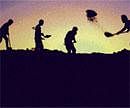
In archaeology, it’s not just bodies we’re talking about; it’s any material remains of the past. This ranges from glamorous palaces, forts, temples, towers and sculptures to tiny articles left over from human life: bones, bits of pottery, coins, inscriptions, toys, tools, ornaments, seeds, even pollen and, believe it or not, ancient, preserved faeces! (Yes, there are people who study ancient poo and it is known by the delicately scientific name of coprology!).
What can these random, scattered and often broken little bits and pieces tell us about the past? Well, this is where training those detective senses comes in. An archaeologist is trained to observe, listen and sense.
Each artefact has a tale and if you listen hard enough, it will soon tell you where it came from, who made it, what sort of person he was, what he ate, the songs he sang, the clothes he wore…
The mystery of the past then slowly begins to reveal itself like a gigantic jigsaw puzzle picture.
This is the story of how the beginning of India’s history almost didn’t get discovered because some people just didn’t listen hard enough.
Some hits, many misses
Till the early 19th century, the main source of information on ancient Indian history was Vedic literature – mainly the Puranas and the Rig Veda. Scholars studying Vedic literature believed that Indian history ‘began’ with the coming of the Aryans invaders from Eastern Europe.
However, little archaeological clues began to pop-up from the North-West of India that there was a prosperous civilisation in the area long before the Aryans came. The Archaeological Survey had not been founded yet, but there were many travellers and adventurers who were amateur archaeology sleuths.
In 1826, a man named Charles Masson came across the mounds of Harappa in the Punjab district (now in Pakistan). There was no way of knowing from those unimpressive heaps of mud and rubble that what lay beneath were the almost intact remains of a magnificent, well-planned city more than 3000 years old! Another traveller named Alexander Burnes visited the site a few years later. Both these men felt strange, similar vibes that something significant lay beneath. Masson imagined it to be the place where Alexander the Great had defeated Porus in battle. Some imagination is better that none, I guess!
Cut to almost 50 years later. The head of the newly established Archaeological Society of India, Alexander Cunningham, checks the place out. He is shocked to find the mounds dug up and exquisitely made bricks being hauled off by railway contractors for the new Lahore-Multan railway line! Scattered about are tools, seals and obviously ancient pottery.
Cunningham studies them and reaches some vague conclusion about them being foreign ware. No action is taken.
Early in the 20th century, the ASI sent out archaeologists to assess the Mohenjodaro and Harappa mounds. In 1911, the Superintending Archaeologist of the Western Circle (ASI), D R Bhandarkar, went to Mohenjodaro for trial excavations. He wrote in his report that he believed the place to be not more than 200 years old because… “the bricks found here are of the modern type”.
Stunning discovery
In 1920, Daya Ram Sahni began excavations at Harappa, and in 1921, R D Banerji started digging around Mohenjodaro. In 1924, almost a hundred years after Masson had sensed something at Harappa, the Director General of the ASI, John Marshall, was able to announce to a stunned world, the discovery of the Indus Valley Civilisation. In one stroke, the known history of India was pushed back by almost 2500 years. It seemed that India had an ancient civilisation that probably had contact with those of ancient Egypt and Mesopotamia. Not only that, here were the remains of the probably the world’s first planned cities and towns!
There has been no looking back since. Indus Valley sites began to pop up with almost boring regularity all over the place. From Afghanistan to Gujarat to Haryana to Western UP, remains of planned townships with the trademark “modern bricks” were being excavated. Archaeologists renamed it the Harappan Civilisation since it was no longer confined to the Indus Valley.
Post partition, the glamorous sites of Mohenjodaro and Harappa went off to Pakistan. Indian archaeologists were miffed. The cradle of Indian Civilisation was not going to be shared so easily. So, very much like when you won’t share your toys with your siblings, they set out to look for some of their own.
And find they did. But the stories of the discovery of the Harappan cities of Kalibangan, Lothal and Dholavira will have to wait for another day.
Pay attention to minor details!
* Early archaeologists were trained in the grand tradition of excavating palaces and temples. To them, the mounds of Harappa and Mohenjodaro must have looked like barren heaps of stone and rubble. “What?! No flashy pyramids or towers, no huge burial chambers, no remains of palaces, no intricately carved statues? What sort of civilisation is this anyway?!”
* They missed some key clues: Mohenjodaro and Harappa are almost 600 kilometres apart. Yet both had exquisitely-made bricks, every one of them in the proportion 1:2:4. This meant that some central authority (like an inspector of bricks or something) was making sure that every town was using a uniform standard of bricks for construction. Not only that, beautiful polished stone weights and measures of uniform proportions were also found in both cities. Seals with strange writing and illustrations meant that the cities that lay buried in the mud had a complex trading system and possibly one of the the earliest written languages in the world!
* An archaeologist with good detective skills soon realises that a tiny, polished stone could give as much information as a huge palace. These ordinary looking stones and bricks eventually revealed a highly sophisticated people living and thriving thousands of years ago.
